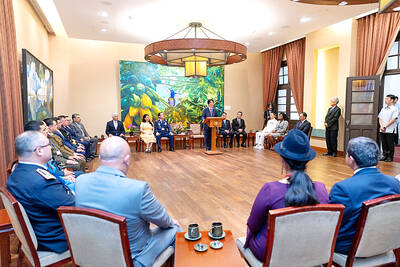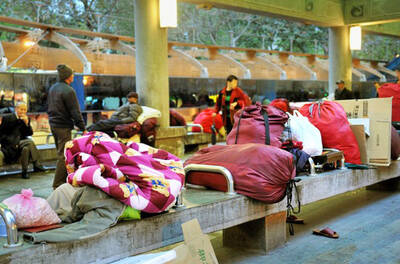Cultural identification is much like identifying with a brand, but New Taipei City’s Banciao District (板橋) seems to be a brand without a story, Funchiao Cultural Society director Chuang Wen-yi (莊文毅) says, expressing hope that the map of old Banciao that his organization recently published can fill in the blanks of the district’s history.
Many people have lived in Banciao for decades and do not realize they are living in a town with a long history, Chuang said, using an example of a conversation with an academic who has lived in Banciao for five decades as an example.
“We were talking about the histories of old towns, and he was pleasantly surprised to learn that Banciao held the remains of an old walled city,” Chuang said.

Photo courtesy of Chuang Wen-yi
“Very few people know that Banciao built its walls three decades before Taipei did, even though the district had streets named after each of the gates,” Chuang said.
The old city of Banciao, then named Funchiao (枋橋), was built in 1855 because of an armed conflict between Han immigrants from China’s Quanzhou and Zhangzhou cities and the family of Lin Pen-yuan (林本源) and others of the local landed gentry.
The walls constructed around the town were 5m high and had five gates, one for each cardinal direction and an additional small east gate, and the walls were in place until the Japanese tore them down in 1903 to facilitate travel, Chuang said.
“It is sad to see the memories of the old cities slowly receding from the memory of the cities’ residents,” Chuang said, adding that he was driven by this thought to recreate the city of old — at least on paper.
“It was a bittersweet process making the map because we saw that despite the rapid expansion of infrastructure in the district over the past several decades, the selfsame expansion was also destroying much of the ‘cultural DNA’ that made up the old city,” Chuang said.
In an effort to be historically accurate with their map project, Chuang and his wife, Lin Hsiu-mei (林秀美), visited many elderly residents of Banciao to verify facts on the city’s layout and the location of buildings.
“We hope that the map of how Banciao looked in the olden days can open the eyes of Banciao residents to new horizons,” Chuang said.
Commenting on his efforts over the past decade to preserve Banciao’s cultural assets, Chuang joked that during the first half of his life, he had only been “half” a Banciao resident, adding that he could not have discovered the beauty of the district if it were not for his wife.
He said he and his wife had been high-school sweethearts and shared a common interest in the arts and the humanities.
After finishing her education, Lin first taught local culture at Banciao’s Da Guan Elementary School, then joined the staff of the Lin Pen-yuan Mansion, compiling historical data and training volunteer tour guides.
In 2007, Lin, along with Taiwan Land Ethical Development Association secretary-general Chen Chien-yi (陳建一) and Da Guan Elementary School teacher Chiu Tzu-jung (邱子容), started a group calling for a halt to an expressway construction to protect the Nanzai Stream (湳仔溪).
The group continued to grow and developed into the Funchiao Cultural Society in 2008.
Speaking of the campaign to protect the Nanzai Stream, Lin said she had never been more aware of how distant the residents of Banciao were from the land they lived on, and she sought to pool community resources and expose more residents to the culture of their local surroundings through concerts and community tours over the past several years.
Lin said that her interest in local culture had at first been borne out of self-interest, but later it had become her own personal quest.
Although the New Taipei City Government Department of Cultural Affairs had originally considered publishing the map, Chuang said certain issues had led to a separation of ways between the agency and himself and that he would shoulder the costs to publish the map himself.
Chuang added that he and Lin were considering drawing another map to show Banciao in the 1950s and recreate the waterways and light rails crisscrossing the district before they were built over or removed.

Costa Rica sent a group of intelligence officials to Taiwan for a short-term training program, the first time the Central American country has done so since the countries ended official diplomatic relations in 2007, a Costa Rican media outlet reported last week. Five officials from the Costa Rican Directorate of Intelligence and Security last month spent 23 days in Taipei undergoing a series of training sessions focused on national security, La Nacion reported on Friday, quoting unnamed sources. The Costa Rican government has not confirmed the report. The Chinese embassy in Costa Rica protested the news, saying in a statement issued the same

Taiwan’s Liu Ming-i, right, who also goes by the name Ray Liu, poses with a Chinese Taipei flag after winning the gold medal in the men’s physique 170cm competition at the International Fitness and Bodybuilding Federation Asian Championship in Ajman, United Arab Emirates, yesterday.

A year-long renovation of Taipei’s Bangka Park (艋舺公園) began yesterday, as city workers fenced off the site and cleared out belongings left by homeless residents who had been living there. Despite protests from displaced residents, a city official defended the government’s relocation efforts, saying transitional housing has been offered. The renovation of the park in Taipei’s Wanhua District (萬華), near Longshan Temple (龍山寺), began at 9am yesterday, as about 20 homeless people packed their belongings and left after being asked to move by city personnel. Among them was a 90-year-old woman surnamed Wang (王), who last week said that she had no plans

TO BE APPEALED: The environment ministry said coal reduction goals had to be reached within two months, which was against the principle of legitimate expectation The Taipei High Administrative Court on Thursday ruled in favor of the Taichung Environmental Protection Bureau in its administrative litigation against the Ministry of Environment for the rescission of a NT$18 million fine (US$609,570) imposed by the bureau on the Taichung Power Plant in 2019 for alleged excess coal power generation. The bureau in November 2019 revised what it said was a “slip of the pen” in the text of the operating permit granted to the plant — which is run by Taiwan Power Co (Taipower) — in October 2017. The permit originally read: “reduce coal use by 40 percent from Jan.